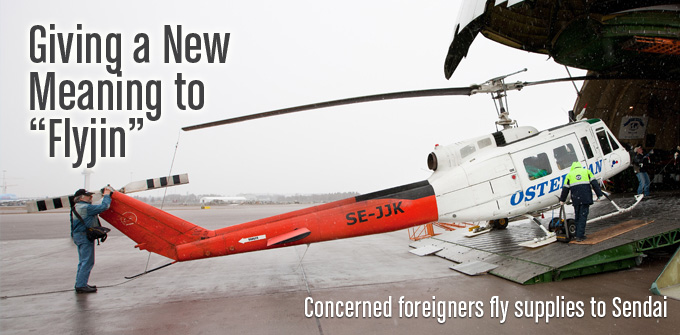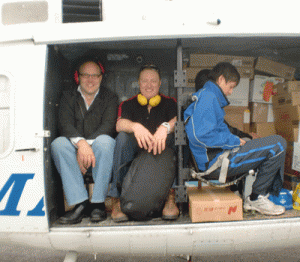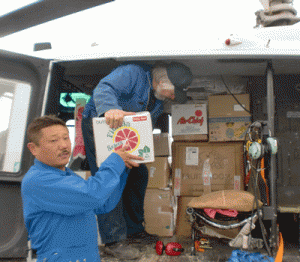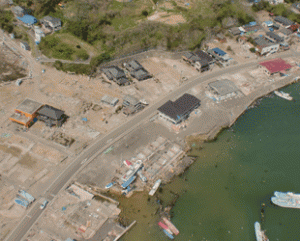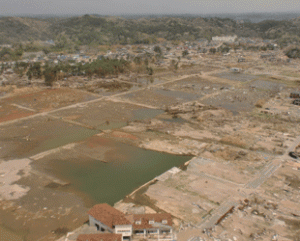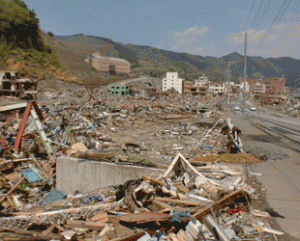Images of the 3/11 disaster flashed across the TV screens of every household in Japan: houses and generations of memories turned to salty rubble, schools diminished to barren halls and rooftops of clutter. These images rendered its viewers hopeless, but the amazing spirit of all Japanese was to fight and help those who were desperate. Amidst the criticism towards foreigners that decided to flee to “safer” places, foreigners that stayed to fight out the crisis alongside the Japanese and furthermore who ventured into the affected areas have not received much attention. Trevor Allen is one of the many gaijin who took the courageous initiative to go North to deliver supplies. His actions have changed the connotation of “flyjin” from fleeing away, to flying to the affected area.
After the tragedy, Allen, along with Japanese and expats searched for ways to help those that lived in the affected areas. After donating to the main international charities, he decided to take his drive to Facebook. He reached out and garnered the support of his personal network of friends here in Tokyo. The response was overwhelmingly generous. People offered advice as to where to donate food and medicine, discussed the Fukushima Plant worries, and connected with each other on a profound level.
They motivated each other to take action, to actually do something. Later, they came across an initiative organized by the telecommunications company Ericsson. This Swedish company chartered a Bell 205 helicopter to send engineers to rebuild destroyed cellular networks. This project would help thousands of victims reconnect with relatives in and outside of the Miyagi Prefecture. The extra room in the helicopter was filled with relief goods from groups of volunteers. Allen (as well as the publisher of the Weekender) took it upon themselves to accompany the engineers on their project.
As Allen landed in Sendai, the surreal imagery that he had seen previously in the news suddenly became very imminent and real. From previous distance and helplessness, he landed to experience, learn and take action. “You can see a lot from the air… You get the view from the scale at 1000ft so vast it is difficult to take it all in. As you descend into the streets or what’s left of them you start to wonder… It’s all too much for the human mind to absorb or the mind to record.” From the window of the helicopter, Allen describes the true extent of the damage:
“On the seaside was utter destruction and desolation, heavy machinery working, other machinery twisted and broken, the cars, the ships… all piled up on each other. Some were left in the fields, gardens, even on top of buildings. As we descended closer, we watched closely as a very few souls tried to make sense out of their surroundings and piece their lives back together.”
Allen describes his heart-wrenching journey through what was left of the streets from the passenger seat: “In the strange silence broken by seagulls, the trucks and vans carrying workers and wreckage up and down through the dust you end up trying to put it all together again like a broken puzzle with too many missing pieces. Where did this come from?” His journey was plagued with questions and thoughts such as “what happens next?” “who’s in charge?” “will they be able to build again on this land?” “what can we do now?” “how can others help?” lingered in the already palpably tense air.
The work that the team Allen had shadowed was extremely helpful. Ericsson Japan’s own Natsuki Kawase commented on their hard work, explaining that, “[Their] helicopter took passengers (medical doctors, and a researcher from a sanitation company) and delivered relief goods from the Japanese Society of Mountain Medicine to the Ishinomaki and Ohzaki relief camps in Miyagi.”
Essential repairs in the mobile network included restoring damaged radio base stations and related technical equipment, restoring power, fixing damaged towers and replacing concrete foundations. In addition to sending the helicopter to Japan, Ericsson is supporting its customer Softbank Mobile with 150 satellite phones, 100 of which were shipped March 25. These are being used to coordinate repair work in areas where mobile communication infrastructure has yet to be restored. Two Ericsson Response volunteers were also dispatched to Japan, to support Softbank in getting the phones up and running. If it wasn’t for swift action by private companies and the kindness of strangers offering food and medicine, relief efforts may have taken much longer.
Although life has resumed to as normal as humanly possible, it is clear that there is still a lot of work to be done. The experience has filled Allen with compassion and motivation to do more.

